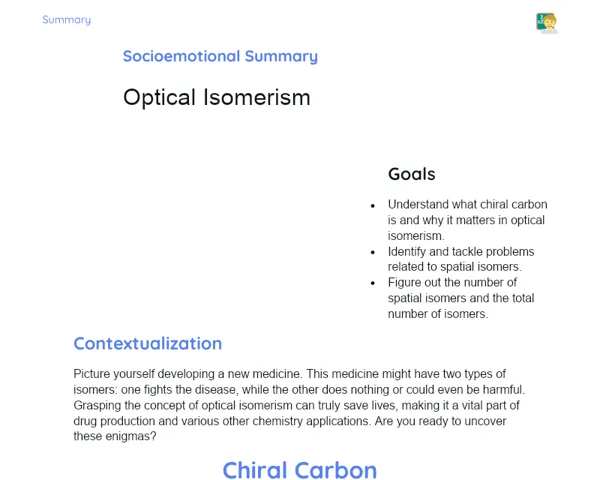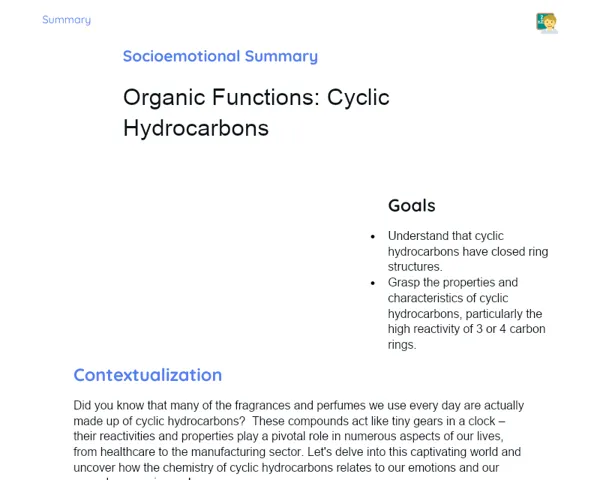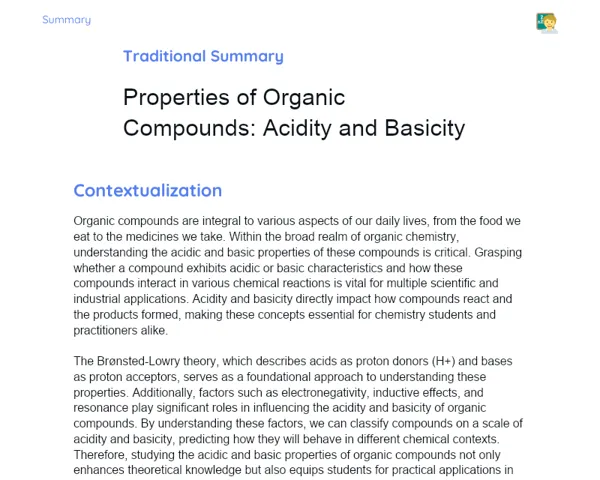Summary Tradisional | Chemical Bonds: Covalent
Contextualization
Covalent bonds play a crucial role in chemistry, as they involve the sharing of electrons between atoms to create stable molecules. This type of bonding is essential for many of the substances we encounter daily, like water (H2O), carbon dioxide (CO2), and various organic compounds that make up living organisms. By understanding covalent bonds, learners can better appreciate how atoms combine to form molecules and how these molecules interact, eventually determining the physical and chemical properties of materials.
During this lesson, we concentrated on the structure and characteristics of covalent bonds. We looked at Lewis structures, which are valuable visual aids to understand how atoms share electrons. Furthermore, we discussed the concept of polarity in covalent bonds, which is influenced by the difference in electronegativity between the atoms involved. Polarity is vital as it affects properties like solubility in water and other intermolecular interactions. We wrapped up our lesson with real-world examples of covalent compounds to make the theoretical content more relevant to our students’ daily lives.
To Remember!
Definition of Covalent Bond
A covalent bond forms when two atoms share one or more pairs of electrons to achieve a stable electronic arrangement similar to that of the noble gases. This type of bond typically occurs between non-metal atoms that have similar electronegativities. By sharing electrons, these atoms can fill their outer shells, producing a stable molecule.
Covalent bonds can be classified as single, double, or triple, depending on how many pairs of electrons are shared. For instance, in a single bond, one pair of electrons is shared between two atoms, as seen in hydrogen gas (H2). In a double bond, two pairs of electrons are shared, like in oxygen gas (O2). A triple bond involves three pairs of shared electrons, as in nitrogen gas (N2).
This electron sharing creates discrete molecules that stand as separate units of covalent bonding. The strength and orientation of a covalent bond are influenced by the overlap of atomic orbitals where the shared electrons reside. This characteristic is vital for defining molecular structures and influences many of the physical and chemical properties of substances.
-
Covalent bonding involves sharing electrons between atoms.
-
Can be classified as single, double, or triple bonds based on shared electron pairs.
-
Results in discrete and stable molecules.
Lewis Structure
The Lewis structure, often referred to as an electron dot diagram, is a visual tool that illustrates the valence electrons of an atom and how they are shared or transferred to form chemical bonds. In this diagram, valence electrons are represented as dots surrounding the symbols of the chemical elements.
To construct a Lewis structure of a molecule, we first identify the total valence electrons available. We then distribute these electrons among the atoms, ensuring that every atom (except hydrogen) achieves an octet configuration, meaning it should have eight electrons in its outer shell. If necessary, double or triple bonds can be formed to ensure stability across all atoms.
The Lewis structure is an effective way to predict molecular shape, reactivity, and the physical properties of substances. It helps to visualize how atoms are connected and how electrons are distributed within a molecule, making it easier to grasp chemical interactions.
-
Presents valence electrons as dots around element symbols.
-
Aids in predicting molecular geometry and reactivity.
-
Enhances understanding of chemical bonds and electron distribution.
Polarity of Covalent Bonds
The polarity of a covalent bond is determined by the difference in electronegativity between the involved atoms. Electronegativity refers to an atom's ability to pull electrons towards itself in a chemical bond. When there is a significant difference in electronegativity between two atoms, the shared electrons are drawn more towards one atom, leading to an uneven distribution of electrical charge.
If the electronegativity difference is considerable, the bond is polar, where one atom develops a partial negative charge (δ-) and the other a partial positive charge (δ+). A classic example is the water molecule (H2O), where oxygen is more electronegative than hydrogen, resulting in an unequal charge distribution that renders the molecule polar.
Conversely, if the electronegativity difference is minor or non-existent, the bond remains nonpolar, with electrons shared equally between the atoms. Examples of nonpolar molecules include methane (CH4) and nitrogen gas (N2). The polarity of molecules influences their physical characteristics, like solubility and boiling point, as well as how they interact with other substances.
-
Depends on the electronegativity difference between atoms.
-
Polar bonds exhibit an uneven charge distribution.
-
Nonpolar bonds have an equal charge distribution.
Properties of Covalent Compounds
Covalent compounds possess unique properties that set them apart from ionic and metallic compounds. A key characteristic is that they typically have lower melting and boiling points. This phenomenon occurs because the intermolecular forces that hold covalent molecules together are weaker than those in ionic or metallic compounds.
Another notable property is their generally low electrical conductivity. In most covalent compounds, electrons are tightly bound to the atoms and are unable to move freely, which prevents electrical conduction. However, exceptions exist, such as graphite, which is a good conductor owing to its free-moving electrons.
Moreover, covalent compounds tend to have lower solubility in water compared to ionic compounds. Water, being a polar molecule, is more adept at dissolving polar or ionic substances. Nonpolar covalent compounds, such as oils and fats, do not dissolve well in water but can mix with nonpolar solvents.
These properties are essential for various practical applications, spanning from pharmaceuticals to engineering materials. Understanding these characteristics helps predict material behavior and their uses.
-
Usually have lower melting and boiling points.
-
Exhibit low electrical conductivity, except in certain cases.
-
Typically less soluble in water.
Key Terms
-
Covalent Bond: Sharing of electrons between atoms to create stable molecules.
-
Lewis Structure: A visual representation of an atom’s valence electrons and its bonding.
-
Polarity: Uneven charge distribution in a bond due to differences in electronegativity.
-
Electronegativity: The ability of an atom to attract electrons during bonding.
-
Covalent Compounds: Substances formed by atoms joined through covalent bonds, characterized by their low electrical conductivity and variable solubility.
Important Conclusions
In this lesson, we delved into the concept of covalent bonds, which are critical for creating stable molecules through electron sharing. We examined the different types of these bonds, including single, double, and triple bonds, and discussed how the Lewis structure can aid in understanding electron distribution.
Additionally, we looked at covalent bond polarity, determined by the electronegativity difference between atoms, which leads to polar or nonpolar bonds. This polarity significantly affects the physical properties of molecules, including solubility and boiling points, as well as their interactions with other substances.
Finally, we reviewed the characteristics of covalent compounds, such as their generally lower melting and boiling points, low electrical conductivity, and varied solubility. This insight is vital for comprehending material behavior and their practical applications, from medications to engineering materials.
Study Tips
-
Revisit Lewis structures and practice sketching various covalent molecules, focusing on how valence electrons are distributed.
-
Familiarize yourself with the periodic table to better understand electronegativity and its effect on bond polarity.
-
Connect the physical properties of covalent compounds to their structures and polarities, using examples from everyday life.



